Clinical Reasoning Cycle Application: Mr. Joni's Case Study Analysis
VerifiedAdded on 2022/09/15
|12
|1259
|21
Presentation
AI Summary
This presentation analyzes Mr. Joni's case study, a 56-year-old man with risk factors including smoking, unhealthy eating habits, and elevated blood pressure, BGL, and cholesterol. The presentation applies the clinical reasoning cycle to identify Mr. Joni's potential to develop type 2 diabetes. It discusses the pathophysiology of type 2 diabetes, its potential consequences such as cardiovascular complications, nerve damage, and impaired vision. The presentation establishes goals for Mr. Joni, outlines an action plan including pharmacological interventions, education on exercise, and dietary modifications. It then describes methods for evaluating the outcome through physical assessments and lifestyle monitoring. The assignment concludes with a reflection on the learning process and the application of the clinical reasoning cycle in developing a care plan. The presentation references relevant literature to support its claims.
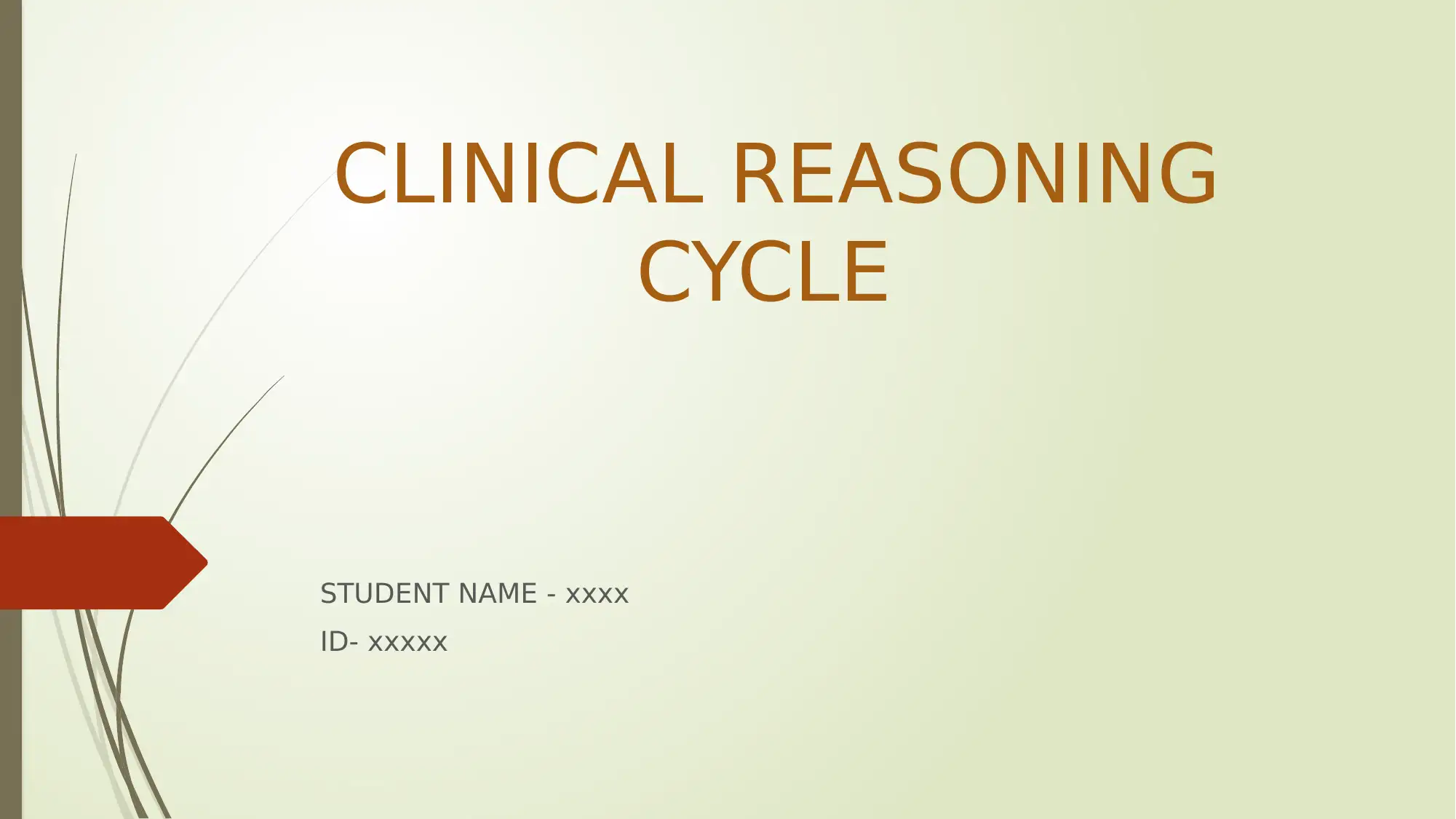
CLINICAL REASONING
CYCLE
STUDENT NAME - xxxx
ID- xxxxx
CYCLE
STUDENT NAME - xxxx
ID- xxxxx
Paraphrase This Document
Need a fresh take? Get an instant paraphrase of this document with our AI Paraphraser
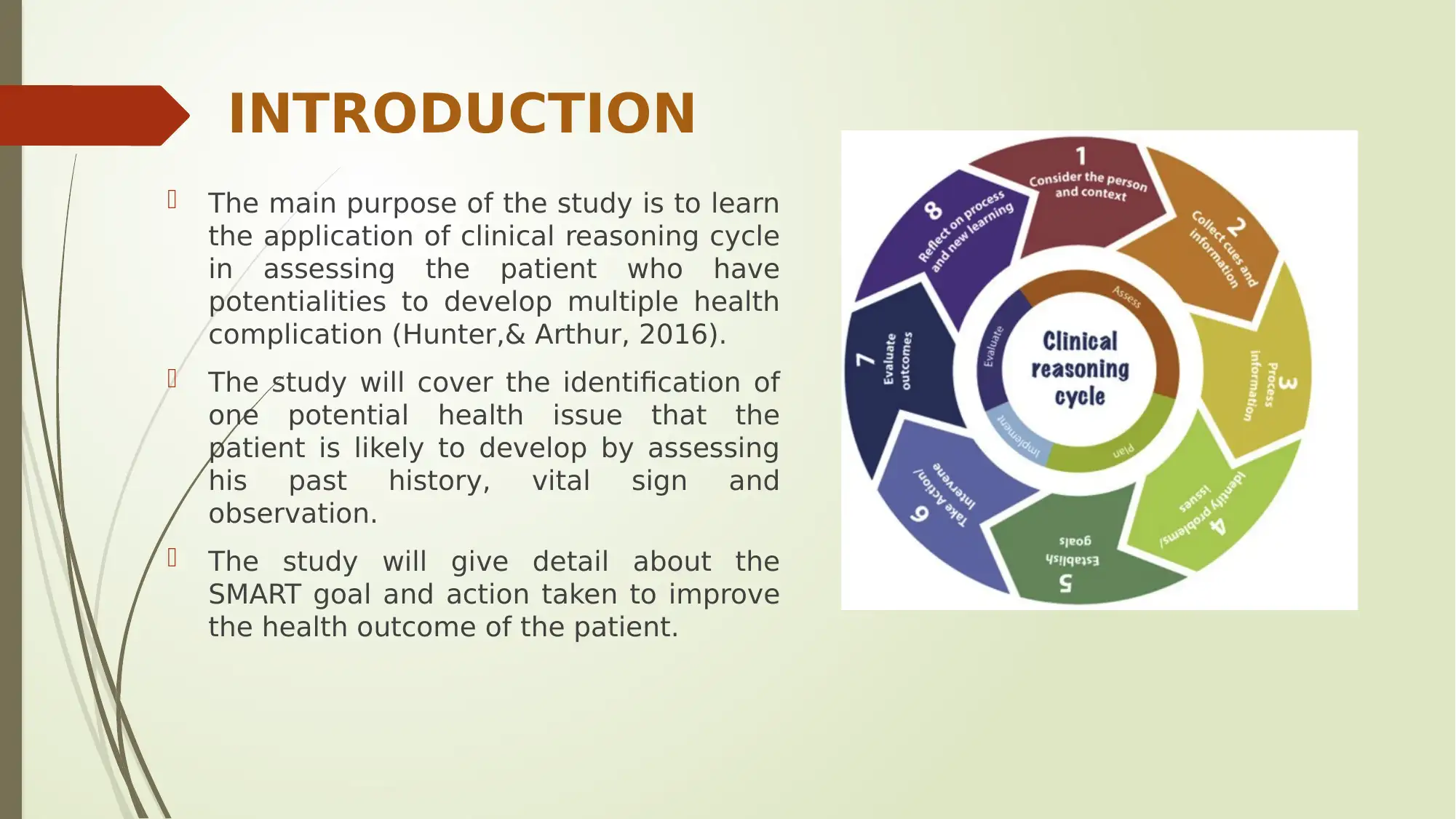
INTRODUCTION
The main purpose of the study is to learn
the application of clinical reasoning cycle
in assessing the patient who have
potentialities to develop multiple health
complication (Hunter,& Arthur, 2016).
The study will cover the identification of
one potential health issue that the
patient is likely to develop by assessing
his past history, vital sign and
observation.
The study will give detail about the
SMART goal and action taken to improve
the health outcome of the patient.
The main purpose of the study is to learn
the application of clinical reasoning cycle
in assessing the patient who have
potentialities to develop multiple health
complication (Hunter,& Arthur, 2016).
The study will cover the identification of
one potential health issue that the
patient is likely to develop by assessing
his past history, vital sign and
observation.
The study will give detail about the
SMART goal and action taken to improve
the health outcome of the patient.
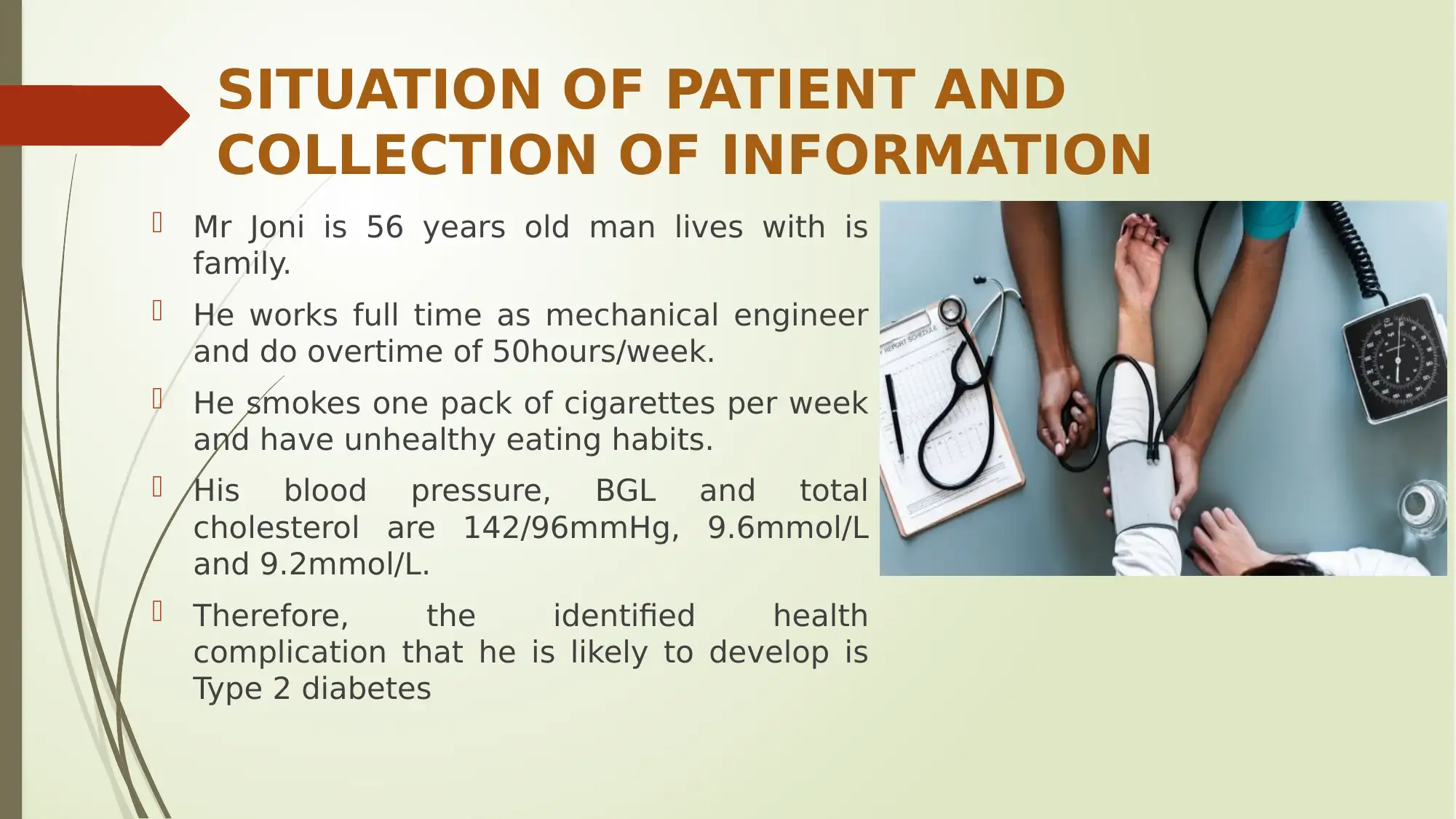
SITUATION OF PATIENT AND
COLLECTION OF INFORMATION
Mr Joni is 56 years old man lives with is
family.
He works full time as mechanical engineer
and do overtime of 50hours/week.
He smokes one pack of cigarettes per week
and have unhealthy eating habits.
His blood pressure, BGL and total
cholesterol are 142/96mmHg, 9.6mmol/L
and 9.2mmol/L.
Therefore, the identified health
complication that he is likely to develop is
Type 2 diabetes
COLLECTION OF INFORMATION
Mr Joni is 56 years old man lives with is
family.
He works full time as mechanical engineer
and do overtime of 50hours/week.
He smokes one pack of cigarettes per week
and have unhealthy eating habits.
His blood pressure, BGL and total
cholesterol are 142/96mmHg, 9.6mmol/L
and 9.2mmol/L.
Therefore, the identified health
complication that he is likely to develop is
Type 2 diabetes
⊘ This is a preview!⊘
Do you want full access?
Subscribe today to unlock all pages.

Trusted by 1+ million students worldwide
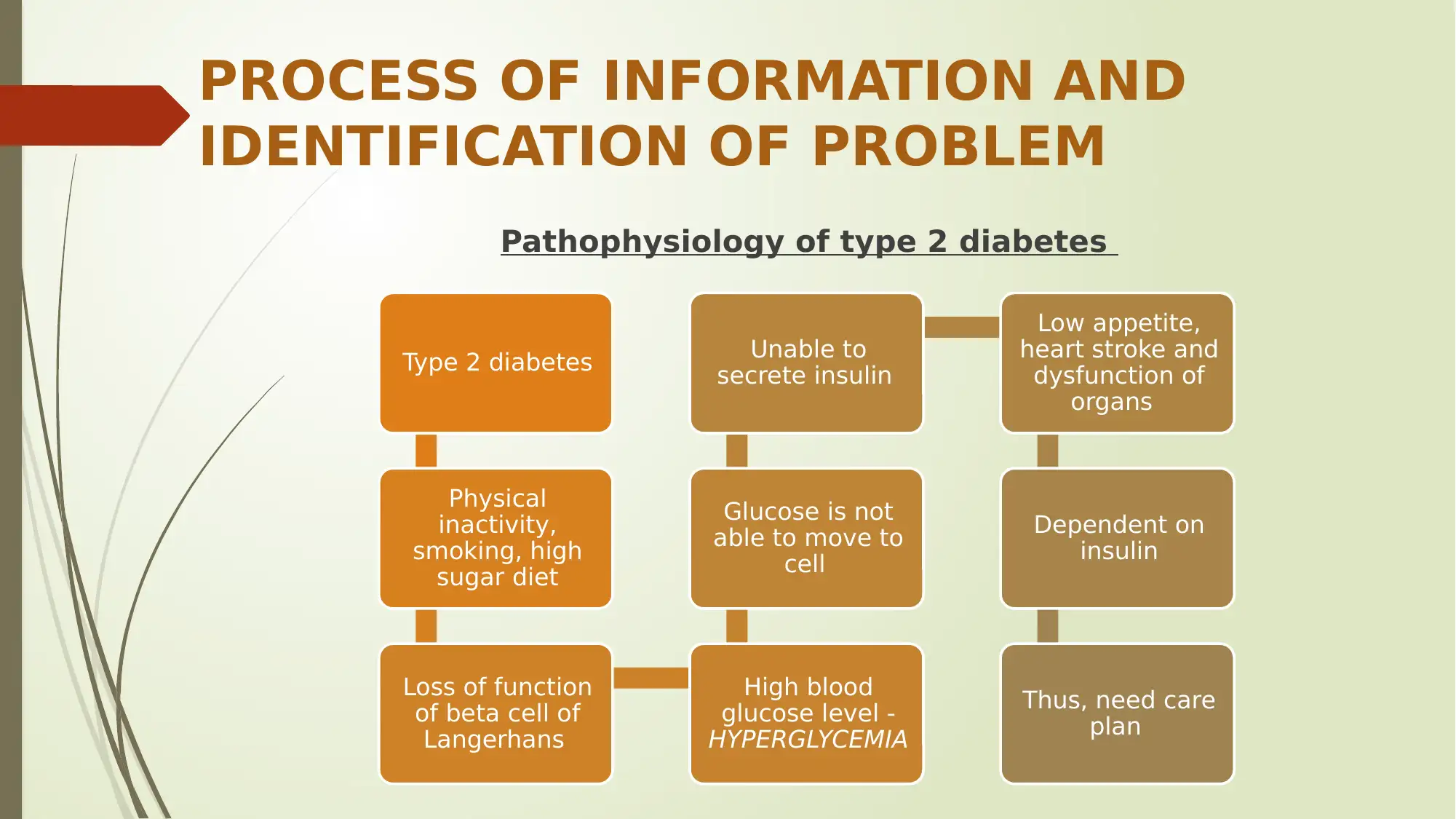
PROCESS OF INFORMATION AND
IDENTIFICATION OF PROBLEM
Pathophysiology of type 2 diabetes
Type 2 diabetes
Physical
inactivity,
smoking, high
sugar diet
Loss of function
of beta cell of
Langerhans
High blood
glucose level -
HYPERGLYCEMIA
Glucose is not
able to move to
cell
Unable to
secrete insulin
Low appetite,
heart stroke and
dysfunction of
organs
Dependent on
insulin
Thus, need care
plan
IDENTIFICATION OF PROBLEM
Pathophysiology of type 2 diabetes
Type 2 diabetes
Physical
inactivity,
smoking, high
sugar diet
Loss of function
of beta cell of
Langerhans
High blood
glucose level -
HYPERGLYCEMIA
Glucose is not
able to move to
cell
Unable to
secrete insulin
Low appetite,
heart stroke and
dysfunction of
organs
Dependent on
insulin
Thus, need care
plan
Paraphrase This Document
Need a fresh take? Get an instant paraphrase of this document with our AI Paraphraser
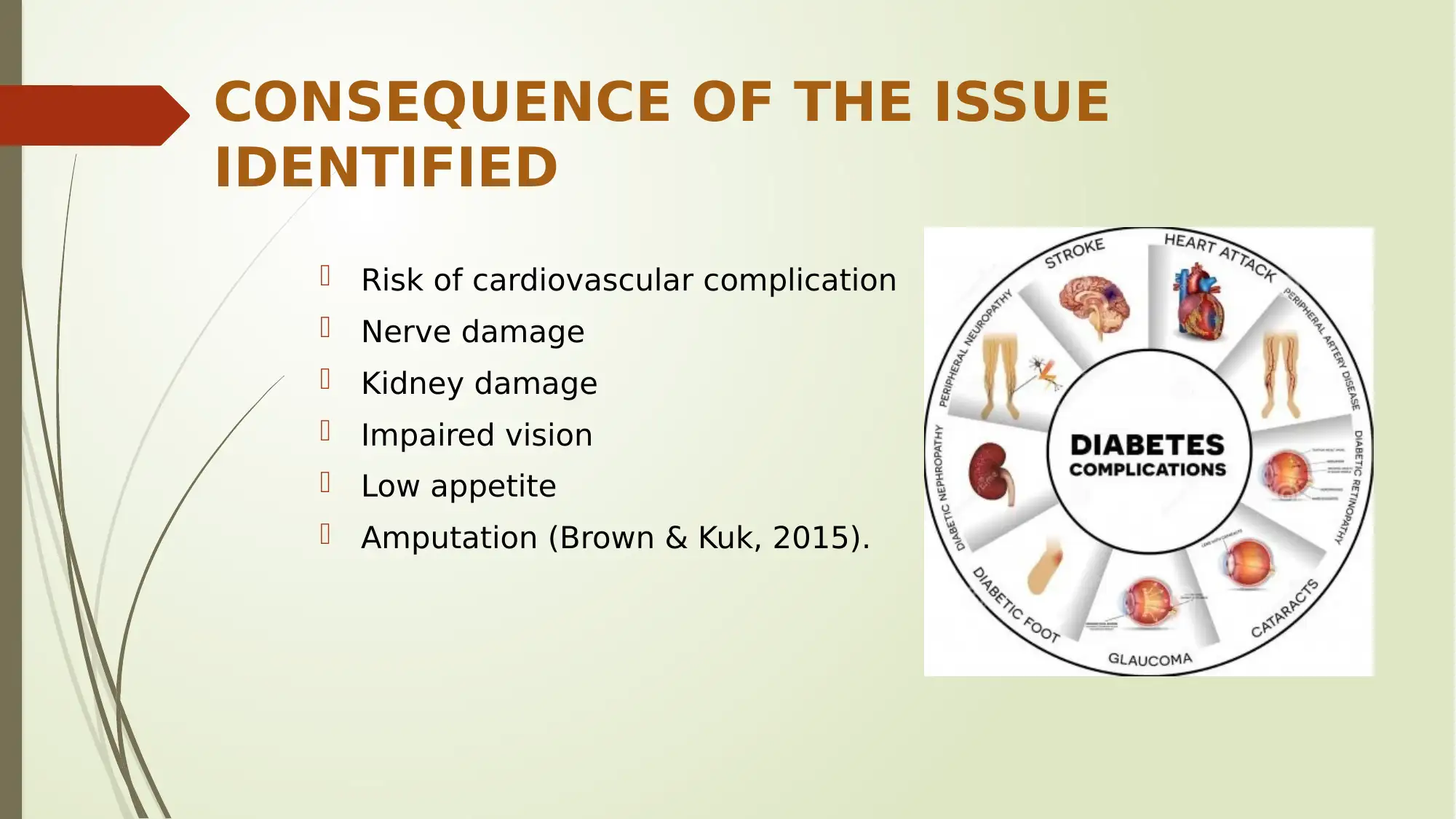
CONSEQUENCE OF THE ISSUE
IDENTIFIED
Risk of cardiovascular complication
Nerve damage
Kidney damage
Impaired vision
Low appetite
Amputation (Brown & Kuk, 2015).
IDENTIFIED
Risk of cardiovascular complication
Nerve damage
Kidney damage
Impaired vision
Low appetite
Amputation (Brown & Kuk, 2015).
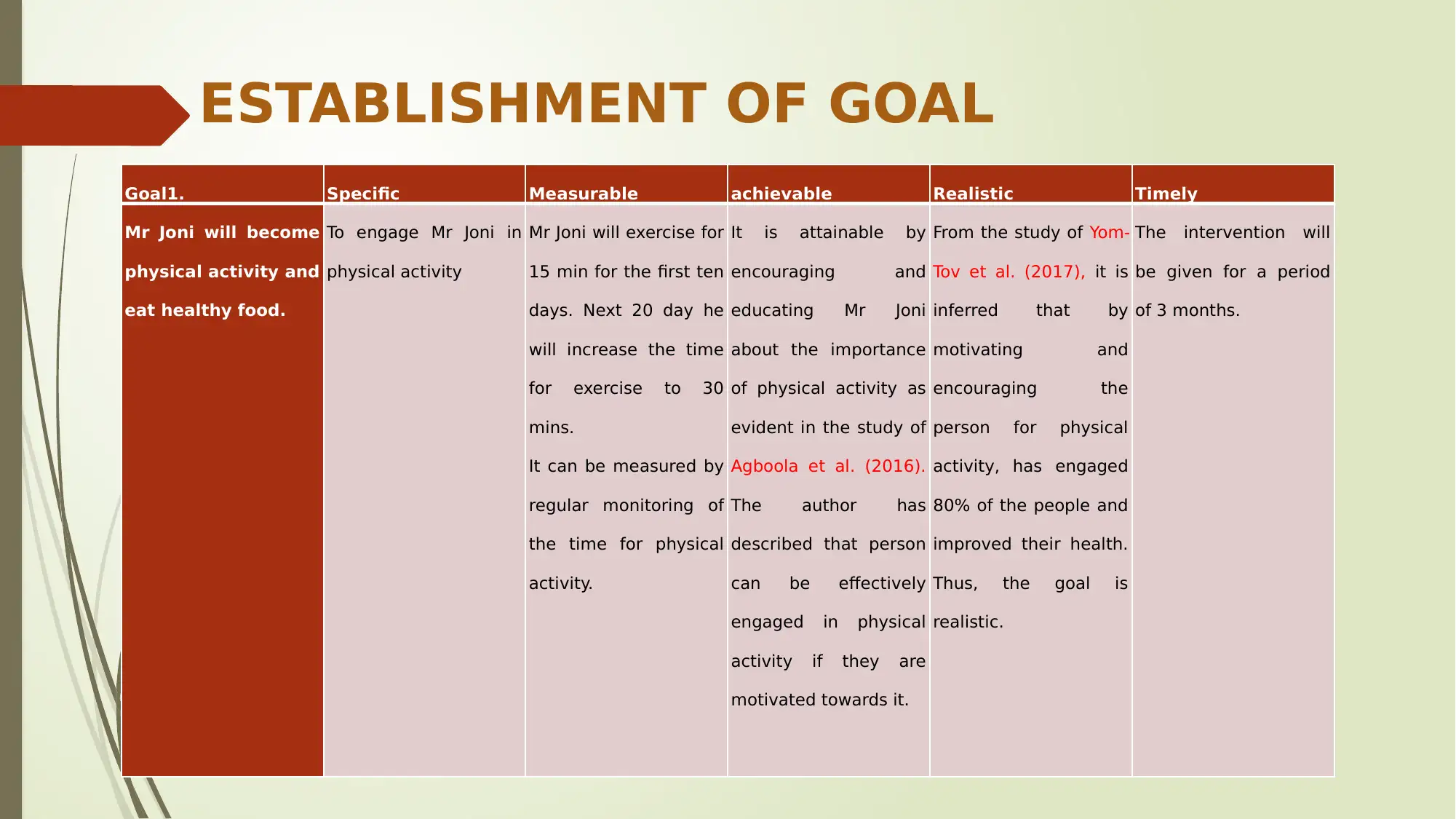
ESTABLISHMENT OF GOAL
Goal1. Specific Measurable achievable Realistic Timely
Mr Joni will become
physical activity and
eat healthy food.
To engage Mr Joni in
physical activity
Mr Joni will exercise for
15 min for the first ten
days. Next 20 day he
will increase the time
for exercise to 30
mins.
It can be measured by
regular monitoring of
the time for physical
activity.
It is attainable by
encouraging and
educating Mr Joni
about the importance
of physical activity as
evident in the study of
Agboola et al. (2016).
The author has
described that person
can be effectively
engaged in physical
activity if they are
motivated towards it.
From the study of Yom-
Tov et al. (2017), it is
inferred that by
motivating and
encouraging the
person for physical
activity, has engaged
80% of the people and
improved their health.
Thus, the goal is
realistic.
The intervention will
be given for a period
of 3 months.
Goal1. Specific Measurable achievable Realistic Timely
Mr Joni will become
physical activity and
eat healthy food.
To engage Mr Joni in
physical activity
Mr Joni will exercise for
15 min for the first ten
days. Next 20 day he
will increase the time
for exercise to 30
mins.
It can be measured by
regular monitoring of
the time for physical
activity.
It is attainable by
encouraging and
educating Mr Joni
about the importance
of physical activity as
evident in the study of
Agboola et al. (2016).
The author has
described that person
can be effectively
engaged in physical
activity if they are
motivated towards it.
From the study of Yom-
Tov et al. (2017), it is
inferred that by
motivating and
encouraging the
person for physical
activity, has engaged
80% of the people and
improved their health.
Thus, the goal is
realistic.
The intervention will
be given for a period
of 3 months.
⊘ This is a preview!⊘
Do you want full access?
Subscribe today to unlock all pages.

Trusted by 1+ million students worldwide
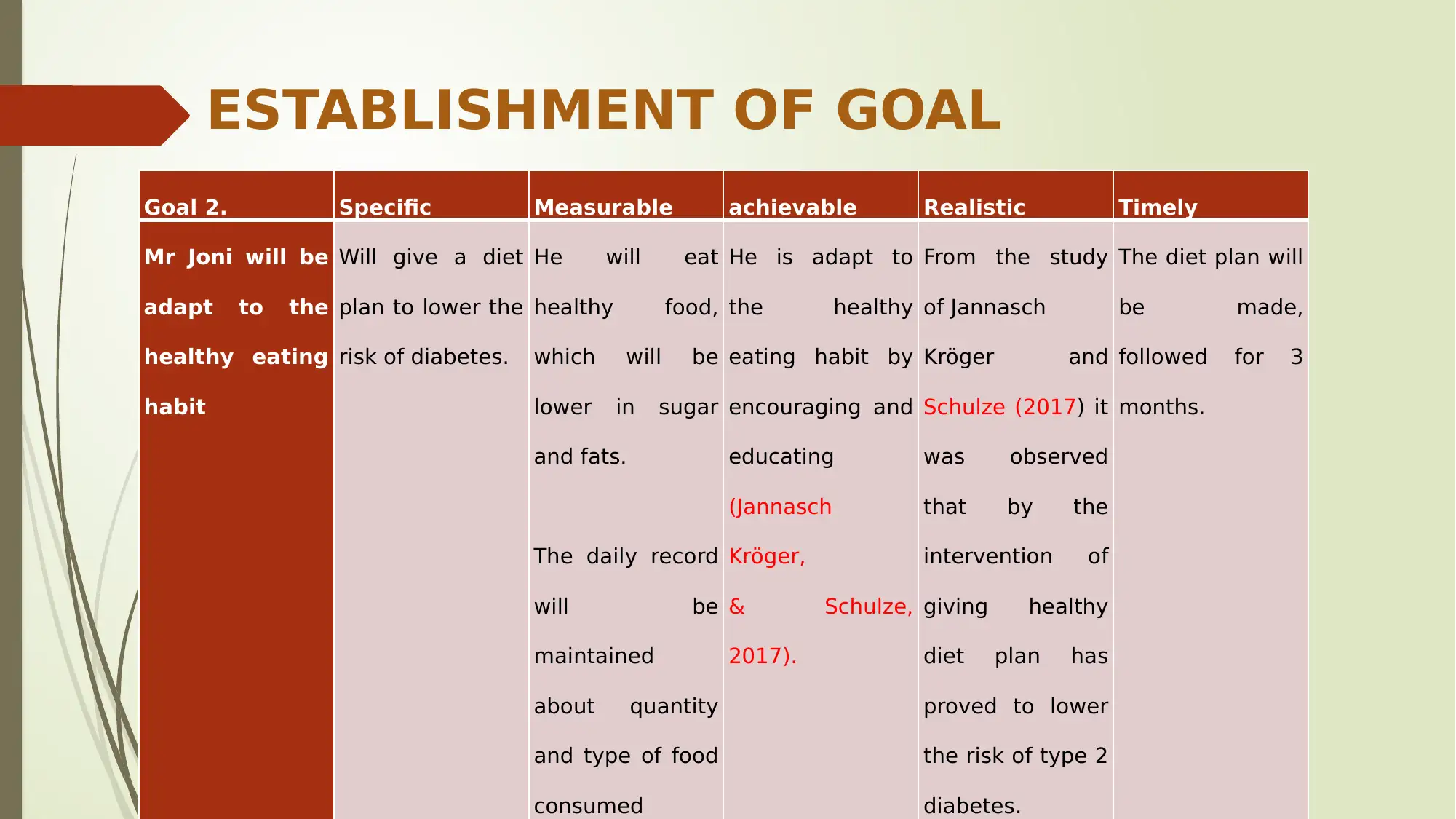
ESTABLISHMENT OF GOAL
Goal 2. Specific Measurable achievable Realistic Timely
Mr Joni will be
adapt to the
healthy eating
habit
Will give a diet
plan to lower the
risk of diabetes.
He will eat
healthy food,
which will be
lower in sugar
and fats.
The daily record
will be
maintained
about quantity
and type of food
consumed
He is adapt to
the healthy
eating habit by
encouraging and
educating
(Jannasch
Kröger,
& Schulze,
2017).
From the study
of Jannasch
Kröger and
Schulze (2017) it
was observed
that by the
intervention of
giving healthy
diet plan has
proved to lower
the risk of type 2
diabetes.
The diet plan will
be made,
followed for 3
months.
Goal 2. Specific Measurable achievable Realistic Timely
Mr Joni will be
adapt to the
healthy eating
habit
Will give a diet
plan to lower the
risk of diabetes.
He will eat
healthy food,
which will be
lower in sugar
and fats.
The daily record
will be
maintained
about quantity
and type of food
consumed
He is adapt to
the healthy
eating habit by
encouraging and
educating
(Jannasch
Kröger,
& Schulze,
2017).
From the study
of Jannasch
Kröger and
Schulze (2017) it
was observed
that by the
intervention of
giving healthy
diet plan has
proved to lower
the risk of type 2
diabetes.
The diet plan will
be made,
followed for 3
months.
Paraphrase This Document
Need a fresh take? Get an instant paraphrase of this document with our AI Paraphraser
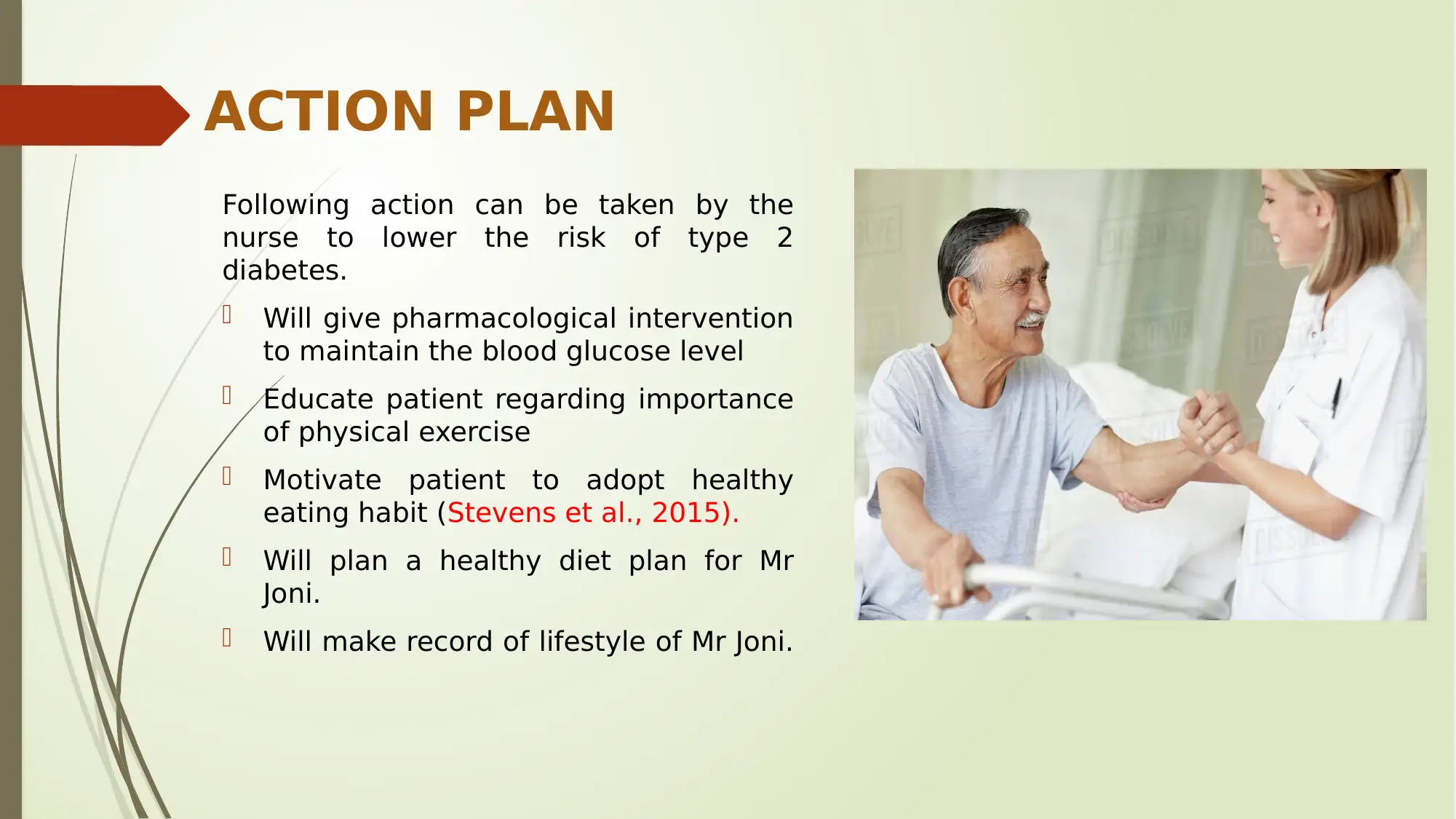
ACTION PLAN
Following action can be taken by the
nurse to lower the risk of type 2
diabetes.
Will give pharmacological intervention
to maintain the blood glucose level
Educate patient regarding importance
of physical exercise
Motivate patient to adopt healthy
eating habit (Stevens et al., 2015).
Will plan a healthy diet plan for Mr
Joni.
Will make record of lifestyle of Mr Joni.
Following action can be taken by the
nurse to lower the risk of type 2
diabetes.
Will give pharmacological intervention
to maintain the blood glucose level
Educate patient regarding importance
of physical exercise
Motivate patient to adopt healthy
eating habit (Stevens et al., 2015).
Will plan a healthy diet plan for Mr
Joni.
Will make record of lifestyle of Mr Joni.
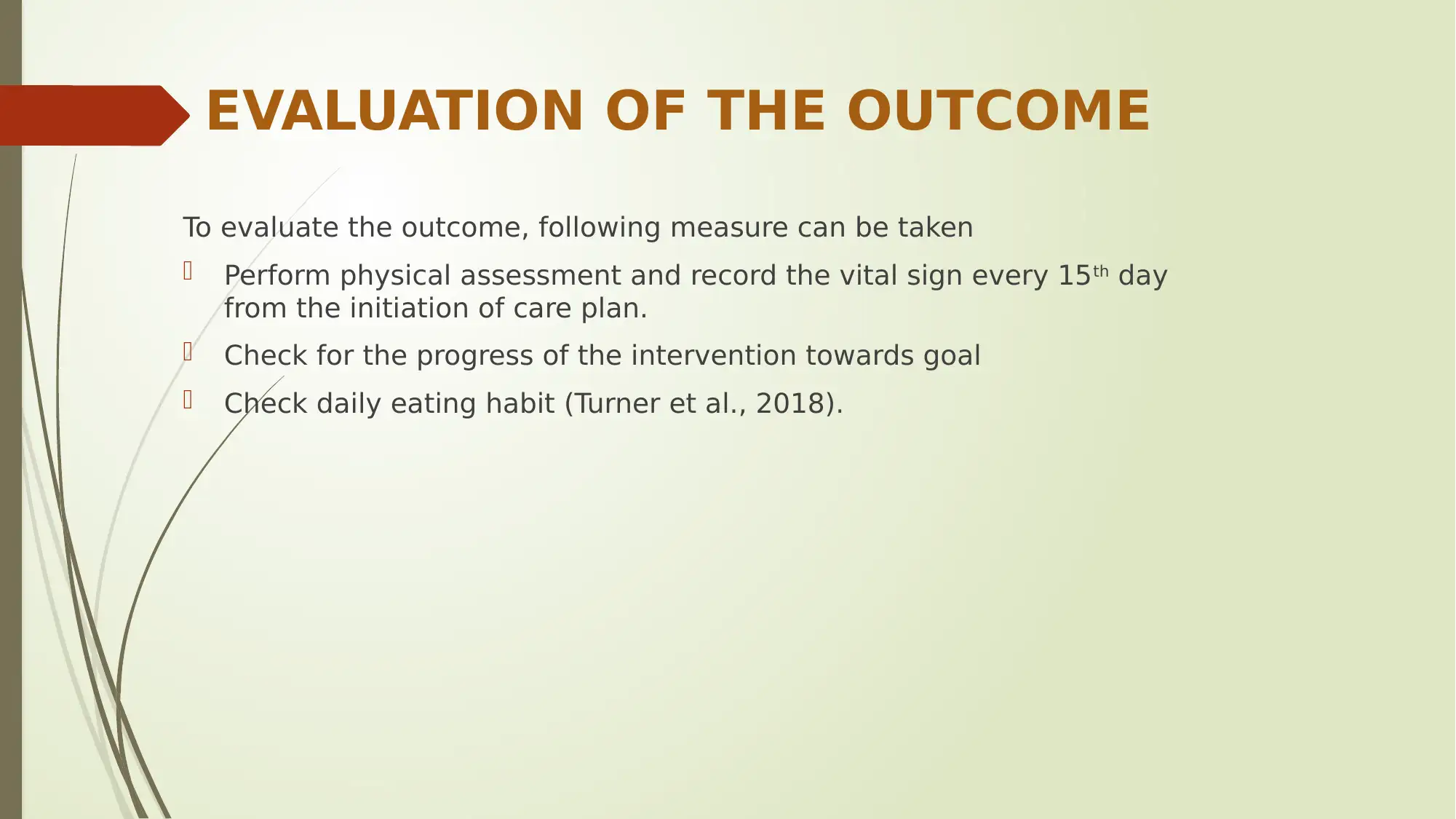
EVALUATION OF THE OUTCOME
To evaluate the outcome, following measure can be taken
Perform physical assessment and record the vital sign every 15th day
from the initiation of care plan.
Check for the progress of the intervention towards goal
Check daily eating habit (Turner et al., 2018).
To evaluate the outcome, following measure can be taken
Perform physical assessment and record the vital sign every 15th day
from the initiation of care plan.
Check for the progress of the intervention towards goal
Check daily eating habit (Turner et al., 2018).
⊘ This is a preview!⊘
Do you want full access?
Subscribe today to unlock all pages.

Trusted by 1+ million students worldwide
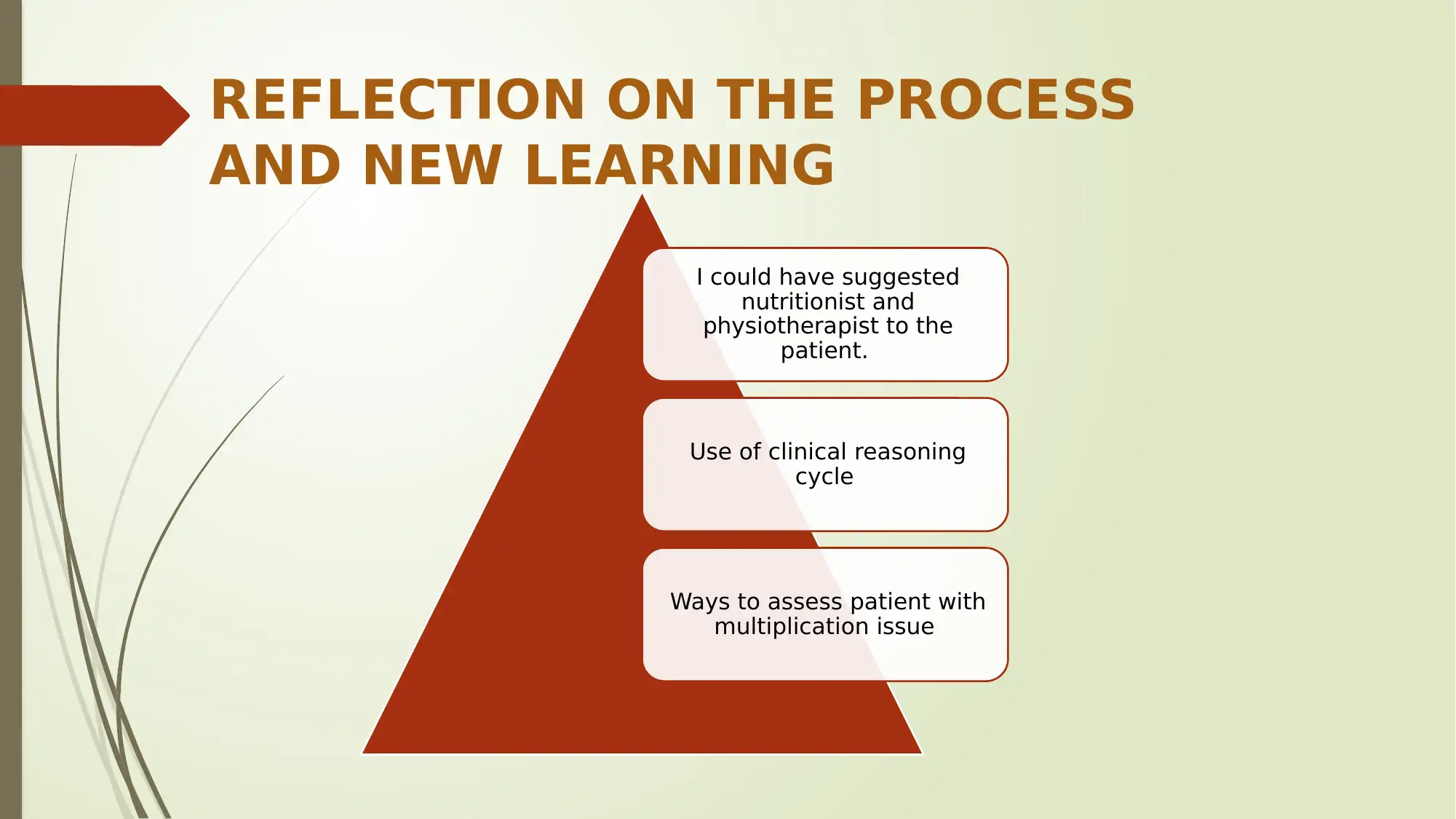
REFLECTION ON THE PROCESS
AND NEW LEARNING
I could have suggested
nutritionist and
physiotherapist to the
patient.
Use of clinical reasoning
cycle
Ways to assess patient with
multiplication issue
AND NEW LEARNING
I could have suggested
nutritionist and
physiotherapist to the
patient.
Use of clinical reasoning
cycle
Ways to assess patient with
multiplication issue
Paraphrase This Document
Need a fresh take? Get an instant paraphrase of this document with our AI Paraphraser
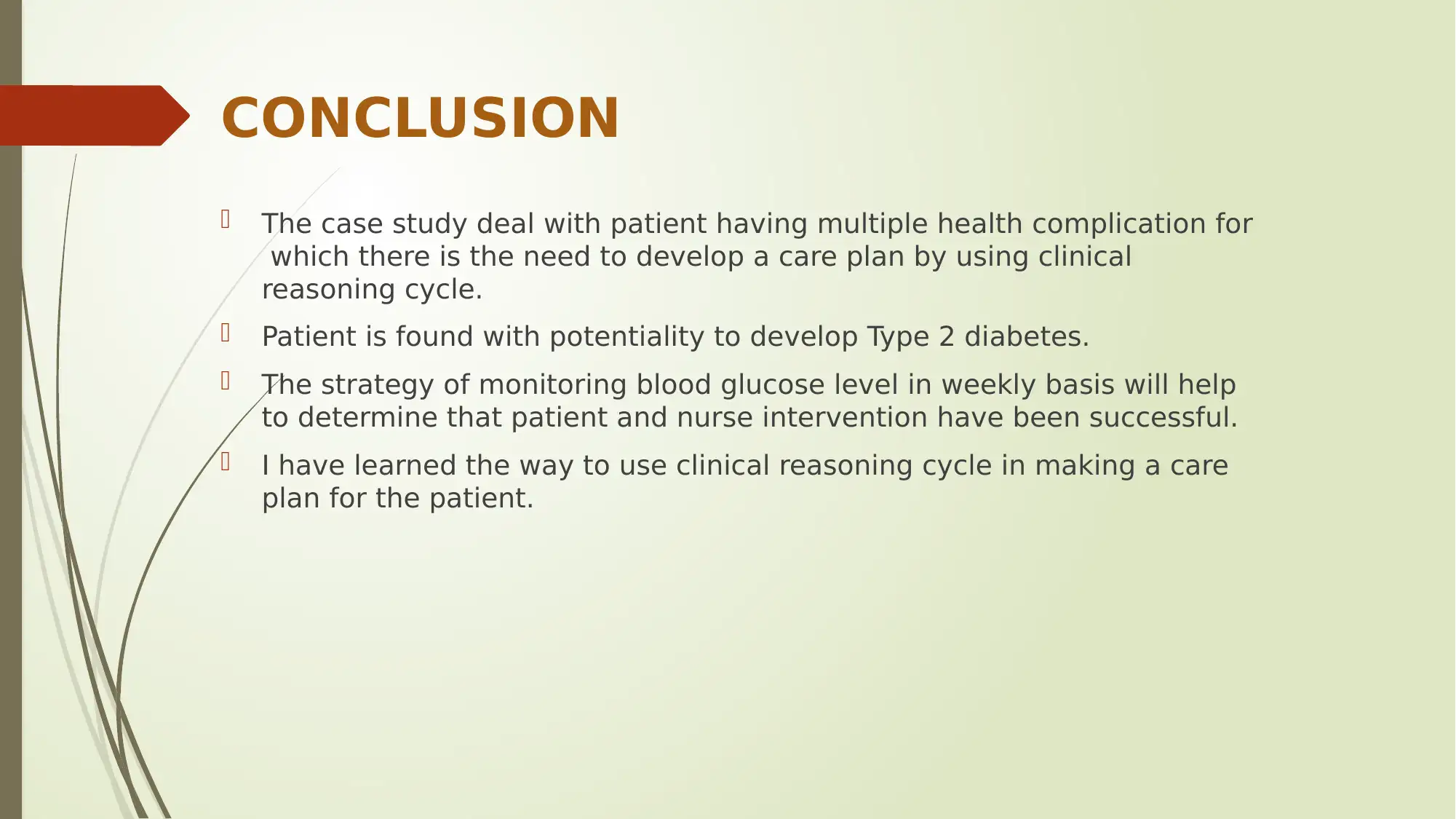
CONCLUSION
The case study deal with patient having multiple health complication for
which there is the need to develop a care plan by using clinical
reasoning cycle.
Patient is found with potentiality to develop Type 2 diabetes.
The strategy of monitoring blood glucose level in weekly basis will help
to determine that patient and nurse intervention have been successful.
I have learned the way to use clinical reasoning cycle in making a care
plan for the patient.
The case study deal with patient having multiple health complication for
which there is the need to develop a care plan by using clinical
reasoning cycle.
Patient is found with potentiality to develop Type 2 diabetes.
The strategy of monitoring blood glucose level in weekly basis will help
to determine that patient and nurse intervention have been successful.
I have learned the way to use clinical reasoning cycle in making a care
plan for the patient.
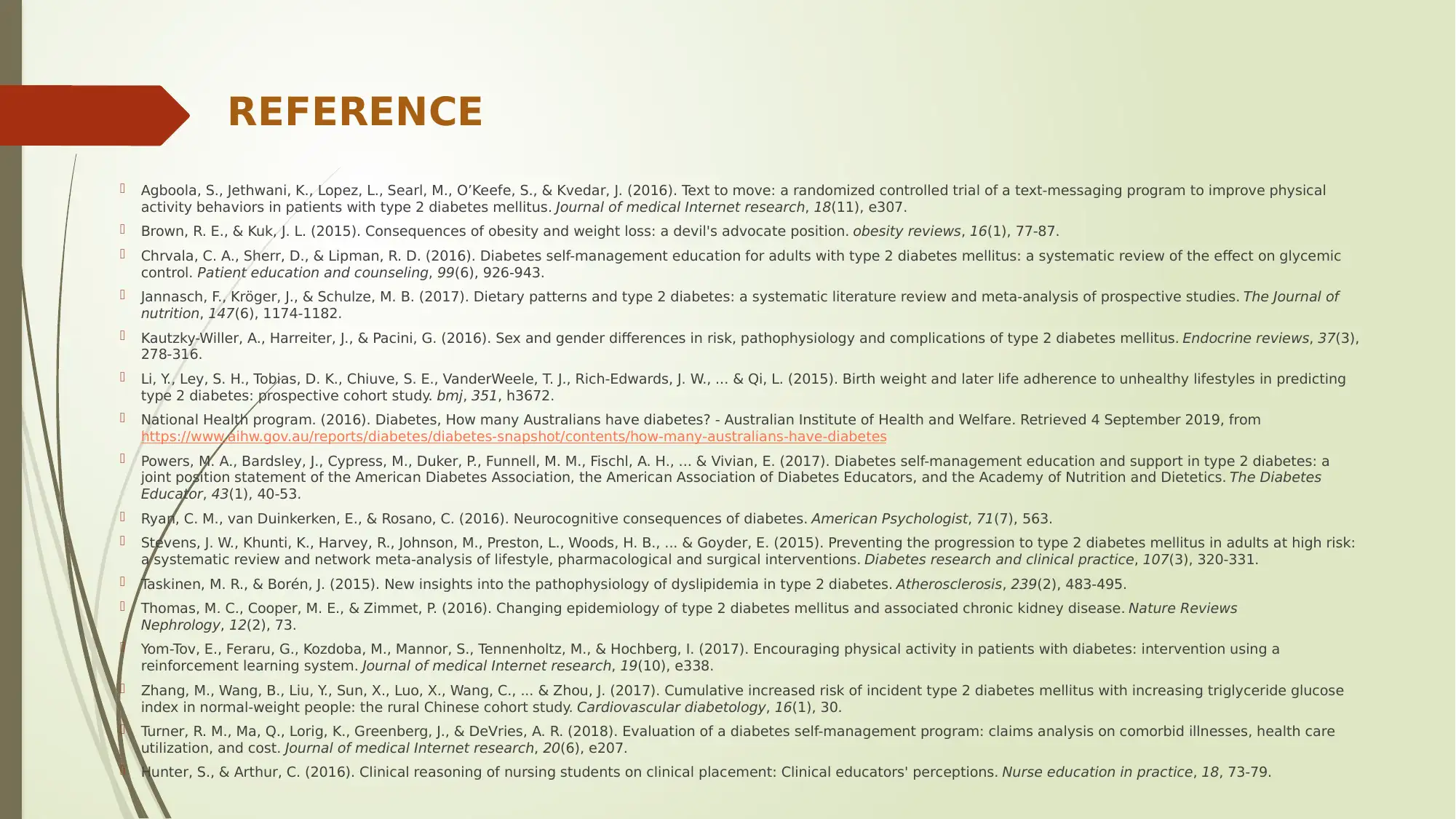
REFERENCE
Agboola, S., Jethwani, K., Lopez, L., Searl, M., O’Keefe, S., & Kvedar, J. (2016). Text to move: a randomized controlled trial of a text-messaging program to improve physical
activity behaviors in patients with type 2 diabetes mellitus. Journal of medical Internet research, 18(11), e307.
Brown, R. E., & Kuk, J. L. (2015). Consequences of obesity and weight loss: a devil's advocate position. obesity reviews, 16(1), 77-87.
Chrvala, C. A., Sherr, D., & Lipman, R. D. (2016). Diabetes self-management education for adults with type 2 diabetes mellitus: a systematic review of the effect on glycemic
control. Patient education and counseling, 99(6), 926-943.
Jannasch, F., Kröger, J., & Schulze, M. B. (2017). Dietary patterns and type 2 diabetes: a systematic literature review and meta-analysis of prospective studies. The Journal of
nutrition, 147(6), 1174-1182.
Kautzky-Willer, A., Harreiter, J., & Pacini, G. (2016). Sex and gender differences in risk, pathophysiology and complications of type 2 diabetes mellitus. Endocrine reviews, 37(3),
278-316.
Li, Y., Ley, S. H., Tobias, D. K., Chiuve, S. E., VanderWeele, T. J., Rich-Edwards, J. W., ... & Qi, L. (2015). Birth weight and later life adherence to unhealthy lifestyles in predicting
type 2 diabetes: prospective cohort study. bmj, 351, h3672.
National Health program. (2016). Diabetes, How many Australians have diabetes? - Australian Institute of Health and Welfare. Retrieved 4 September 2019, from
https://www.aihw.gov.au/reports/diabetes/diabetes-snapshot/contents/how-many-australians-have-diabetes
Powers, M. A., Bardsley, J., Cypress, M., Duker, P., Funnell, M. M., Fischl, A. H., ... & Vivian, E. (2017). Diabetes self-management education and support in type 2 diabetes: a
joint position statement of the American Diabetes Association, the American Association of Diabetes Educators, and the Academy of Nutrition and Dietetics. The Diabetes
Educator, 43(1), 40-53.
Ryan, C. M., van Duinkerken, E., & Rosano, C. (2016). Neurocognitive consequences of diabetes. American Psychologist, 71(7), 563.
Stevens, J. W., Khunti, K., Harvey, R., Johnson, M., Preston, L., Woods, H. B., ... & Goyder, E. (2015). Preventing the progression to type 2 diabetes mellitus in adults at high risk:
a systematic review and network meta-analysis of lifestyle, pharmacological and surgical interventions. Diabetes research and clinical practice, 107(3), 320-331.
Taskinen, M. R., & Borén, J. (2015). New insights into the pathophysiology of dyslipidemia in type 2 diabetes. Atherosclerosis, 239(2), 483-495.
Thomas, M. C., Cooper, M. E., & Zimmet, P. (2016). Changing epidemiology of type 2 diabetes mellitus and associated chronic kidney disease. Nature Reviews
Nephrology, 12(2), 73.
Yom-Tov, E., Feraru, G., Kozdoba, M., Mannor, S., Tennenholtz, M., & Hochberg, I. (2017). Encouraging physical activity in patients with diabetes: intervention using a
reinforcement learning system. Journal of medical Internet research, 19(10), e338.
Zhang, M., Wang, B., Liu, Y., Sun, X., Luo, X., Wang, C., ... & Zhou, J. (2017). Cumulative increased risk of incident type 2 diabetes mellitus with increasing triglyceride glucose
index in normal-weight people: the rural Chinese cohort study. Cardiovascular diabetology, 16(1), 30.
Turner, R. M., Ma, Q., Lorig, K., Greenberg, J., & DeVries, A. R. (2018). Evaluation of a diabetes self-management program: claims analysis on comorbid illnesses, health care
utilization, and cost. Journal of medical Internet research, 20(6), e207.
Hunter, S., & Arthur, C. (2016). Clinical reasoning of nursing students on clinical placement: Clinical educators' perceptions. Nurse education in practice, 18, 73-79.
Agboola, S., Jethwani, K., Lopez, L., Searl, M., O’Keefe, S., & Kvedar, J. (2016). Text to move: a randomized controlled trial of a text-messaging program to improve physical
activity behaviors in patients with type 2 diabetes mellitus. Journal of medical Internet research, 18(11), e307.
Brown, R. E., & Kuk, J. L. (2015). Consequences of obesity and weight loss: a devil's advocate position. obesity reviews, 16(1), 77-87.
Chrvala, C. A., Sherr, D., & Lipman, R. D. (2016). Diabetes self-management education for adults with type 2 diabetes mellitus: a systematic review of the effect on glycemic
control. Patient education and counseling, 99(6), 926-943.
Jannasch, F., Kröger, J., & Schulze, M. B. (2017). Dietary patterns and type 2 diabetes: a systematic literature review and meta-analysis of prospective studies. The Journal of
nutrition, 147(6), 1174-1182.
Kautzky-Willer, A., Harreiter, J., & Pacini, G. (2016). Sex and gender differences in risk, pathophysiology and complications of type 2 diabetes mellitus. Endocrine reviews, 37(3),
278-316.
Li, Y., Ley, S. H., Tobias, D. K., Chiuve, S. E., VanderWeele, T. J., Rich-Edwards, J. W., ... & Qi, L. (2015). Birth weight and later life adherence to unhealthy lifestyles in predicting
type 2 diabetes: prospective cohort study. bmj, 351, h3672.
National Health program. (2016). Diabetes, How many Australians have diabetes? - Australian Institute of Health and Welfare. Retrieved 4 September 2019, from
https://www.aihw.gov.au/reports/diabetes/diabetes-snapshot/contents/how-many-australians-have-diabetes
Powers, M. A., Bardsley, J., Cypress, M., Duker, P., Funnell, M. M., Fischl, A. H., ... & Vivian, E. (2017). Diabetes self-management education and support in type 2 diabetes: a
joint position statement of the American Diabetes Association, the American Association of Diabetes Educators, and the Academy of Nutrition and Dietetics. The Diabetes
Educator, 43(1), 40-53.
Ryan, C. M., van Duinkerken, E., & Rosano, C. (2016). Neurocognitive consequences of diabetes. American Psychologist, 71(7), 563.
Stevens, J. W., Khunti, K., Harvey, R., Johnson, M., Preston, L., Woods, H. B., ... & Goyder, E. (2015). Preventing the progression to type 2 diabetes mellitus in adults at high risk:
a systematic review and network meta-analysis of lifestyle, pharmacological and surgical interventions. Diabetes research and clinical practice, 107(3), 320-331.
Taskinen, M. R., & Borén, J. (2015). New insights into the pathophysiology of dyslipidemia in type 2 diabetes. Atherosclerosis, 239(2), 483-495.
Thomas, M. C., Cooper, M. E., & Zimmet, P. (2016). Changing epidemiology of type 2 diabetes mellitus and associated chronic kidney disease. Nature Reviews
Nephrology, 12(2), 73.
Yom-Tov, E., Feraru, G., Kozdoba, M., Mannor, S., Tennenholtz, M., & Hochberg, I. (2017). Encouraging physical activity in patients with diabetes: intervention using a
reinforcement learning system. Journal of medical Internet research, 19(10), e338.
Zhang, M., Wang, B., Liu, Y., Sun, X., Luo, X., Wang, C., ... & Zhou, J. (2017). Cumulative increased risk of incident type 2 diabetes mellitus with increasing triglyceride glucose
index in normal-weight people: the rural Chinese cohort study. Cardiovascular diabetology, 16(1), 30.
Turner, R. M., Ma, Q., Lorig, K., Greenberg, J., & DeVries, A. R. (2018). Evaluation of a diabetes self-management program: claims analysis on comorbid illnesses, health care
utilization, and cost. Journal of medical Internet research, 20(6), e207.
Hunter, S., & Arthur, C. (2016). Clinical reasoning of nursing students on clinical placement: Clinical educators' perceptions. Nurse education in practice, 18, 73-79.
⊘ This is a preview!⊘
Do you want full access?
Subscribe today to unlock all pages.

Trusted by 1+ million students worldwide
1 out of 12
Related Documents
Your All-in-One AI-Powered Toolkit for Academic Success.
+13062052269
info@desklib.com
Available 24*7 on WhatsApp / Email
![[object Object]](/_next/static/media/star-bottom.7253800d.svg)
Unlock your academic potential
Copyright © 2020–2025 A2Z Services. All Rights Reserved. Developed and managed by ZUCOL.




